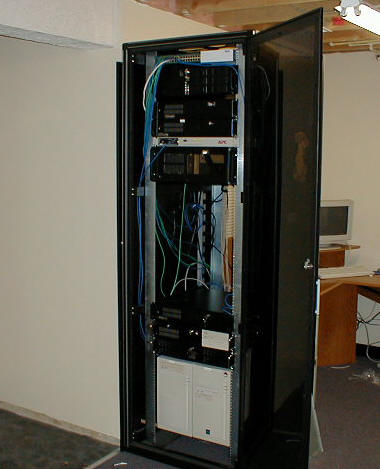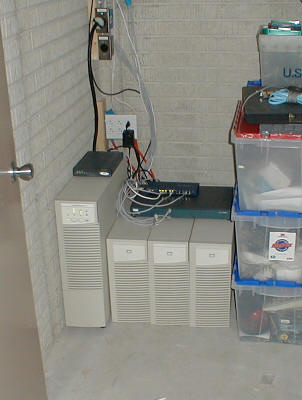- Details
- Written by: Coyote Linux
- Category: Historical Site News
- Hits: 20
Just for kicks, I have put together a page on what I did to move the Coyote Linux site (and many others) into the basement of my house. I managed to scrape together the equipment to provide many of the services typically found in much larger facilities (tons of UPS power, controlled temperature, prewired / preplanned network wiring layout, security system, and [eventual] generator power).
Building a datacenter in a basement
For those of you interested in this sort of thing, here are some pictures of the equipment and location that I have recently moved all of my servers to. In an effort to provide better service for my customers, reduce costs, and have better access to my equipment, I recently moved my web hosting company into my new house. The basement has been specially fitted to house my company, as described here.
When I bought the house, the basement was unfinished and large/open enough for a very nice sized office. Overall the basement was roughly 600sq feet of open space. This space has been dry walled, carpeted and wired to hold my company. 16 CAT-5 drops were placed in the walls, 40 Amps of dedicated electrical service (2 - 120VAC 20A circuits and a single 240VAC 20A) were run, several UPS fed outlets as well as non-UPS were run to nearly every wall. A 3.3kw UPS was enclosed in a small room that holds the furnace and water heater (which is properly drained though the floor into a sump pump to prevent flooding).
Finally, I am working getting an alarm system and small generator installed... this should pretty well wrap up the basement-datacenter project. So far I have not had any cooling problems as the room stays at a pretty consistent 70 degrees F... if additional equipment is added and it becomes a problem, a small, additional A/C unit could easily be added as the back of the basement is exposed and has windows.
While this setup looks pretty ridiculous next to a class-A, raised floor, corporate datacenter (like to one I work in on a daily basis), it does provide a pretty decent environment for PC based servers that run a small company. Not to mention it was a few million buck cheaper to put together :).
Here is a picture of the servers that provide hosting, DNS, monitoring, etc for the web hosting company (Vortech.net) that supports the development of Coyote Linux. A few of these belong to outside companies that use Vortech.net for server co-location. Behind the rack is the terminal that is connected to all of the servers via a 16 port KVM switch. For those of you that have a small, Linux website hosted with Vortech.net, it is contained on the bottom right server (mustang).

This is my desk. The leftmost machine is the file/backup/database/print server that I use to store my personal/company files and data. The center system is my workstation and the laptop is connected to the Road Runner network so that I can test connectivity from outside my web hosting company. The server is a dual 650Mhz P-III with 512MB Ram and 200Gb of U2W SCSI disk space, the workstation is an AMD Athlon 1.4Ghz with 512Mb RAM and 100Gb of disk. The laptop actually belongs to the company that I work for (my real job).

This is a picture of an additional desk/computer that is set up in the basement that is typically used by my wife for playing online card games and some occasional phone survey work that she does from home. The system is a 1.4Ghz Athlon with 512Mb of RAM and has a LaserJet 3200 Fax/Copier/Scanner hooked to it.

This is a picture of the UPS that powers all of the computer equipment. It is a 3.3kw (5kva) UPS with 3 external 6kva battery packs. On top of this equipment is a Cisco 2501 router for my T1, the switch that interconnects my personal machines, and the Road Runner cable modem for the laptop.

Last but not least, here is the machine that serves www.coyotelinux.com, update.coyotelinux.com, and ftp.coyotelinux.com. This system also provides backup services for the rest of the network via an internal DLT tape drive. This system is a Dual 450Mhz P-III with 256 Mb of RAM and 75Gb of ATA/66 Disk Space.
- Details
- Written by: Coyote Linux
- Category: Historical Site News
- Hits: 19
Well, the dust has settled and the Coyote site is now fully back online in a new location. As part of this move, the available bandwidth for this site has been reduced from a burstable 100Mbps connection to a dedicated T1. While I am now allowed to move much more that the previously allocated 50Gb/month, the overall speed of the connection is slower. At the previous location, this site moved roughly 1.25Gb to 2Gb per day with throughput spikes of over 5Mbps. I would like to ask any of you that have stable web/ftp space that would be willing to provide mirror space to please send me an email at
This move was made in an effort to provide better customer service for those customers that have web sites hosted with Vortech.net. As a result, I would like to reserve as much of the new T1 for these customers as possible.
Thanks,
Josh
- Details
- Written by: Coyote Linux
- Category: Historical Site News
- Hits: 19
In a tragedy of errors, the content for the Coyote Linux site has been lost.
In a sequence of events that left me scratching my head and asking "how-in-the-holy-hell-did-I-manage-this-one", I managed to destroy the contents of the Coyote Linux web site and the tape that I backed it up to.
I am working on restoring the HTML content from an older backup of the site, but there is still a ton of work to be done to get things back to normal. The contents of the Forums, FTP site, download areas, and my development environment were unaffected and the Coyote product itself is fine, I just need to get a web site back up.
My Appologies,
Josh
- Details
- Written by: Coyote Linux
- Category: Historical Site News
- Hits: 19
I don't normally make annoucements like this one, but I figured it was note worthy. My copy of Borland Kylix 2 arrived today and I must say that I am VERY happy with it. So far it has been rock stable on my Red Hat 7.2/KDE/Linux-2.4.13 desktop machine. I have already started working on several applications for Embedded Coyote Linux remote management. A considerable deal of effort is being put into sticking with the cross-platform components and code libraries so that Embedded Coyote Linux will have a complete administration suite that works in Linux as well as on Windows.
- Details
- Written by: Coyote Linux
- Category: Historical Site News
- Hits: 20
Several changes are being made to the Coyote Linux web site to merge some of the various areas of the site. This is being done to (hopefully) make information easier to find as additional products and services are made available in the near future. Most notably, the Embedded Coyote Linux project and documentation areas are being updated due to the fact that it is now the primary development project.
